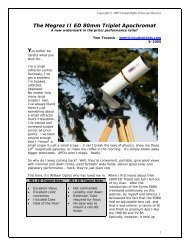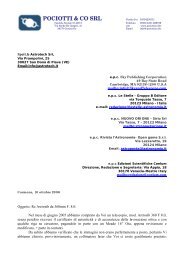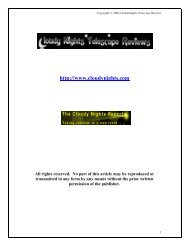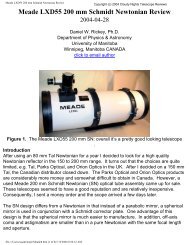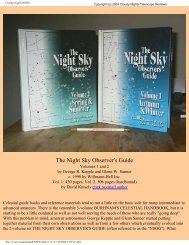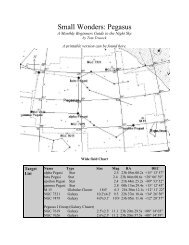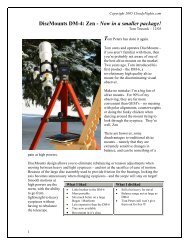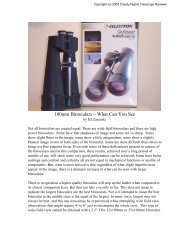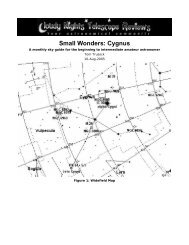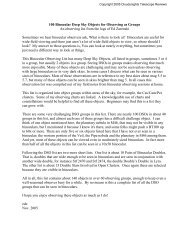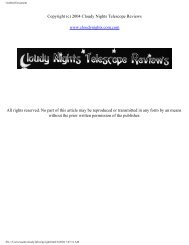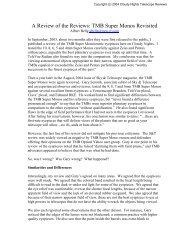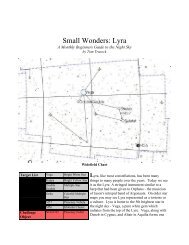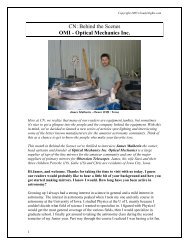Reflex Finder Shootout - Cloudy Nights
Reflex Finder Shootout - Cloudy Nights
Reflex Finder Shootout - Cloudy Nights
You also want an ePaper? Increase the reach of your titles
YUMPU automatically turns print PDFs into web optimized ePapers that Google loves.
The <strong>Reflex</strong> <strong>Finder</strong> <strong>Shootout</strong><br />
5/2004 Tom Trusock - Click to e-mail author<br />
Copyright © 2004 <strong>Cloudy</strong><strong>Nights</strong> Telescope Reviews<br />
Unit Power <strong>Finder</strong>s, <strong>Reflex</strong> <strong>Finder</strong>s, Reticule <strong>Finder</strong>s and Red Dot <strong>Finder</strong>s or RDF’s<br />
call them by any name you like, many amateurs today have one of these units on their<br />
scope. For some, it replaces the traditional optical finder scope, for others it supplements<br />
it. Depending on the size and the focal ratio of the telescope, I personally find that I<br />
either prefer a reflex finder or both optical and reflex units.<br />
A reflex finder allows me to quickly and accurately place an object in the FOV of most of<br />
my eyepieces (even at moderate to high powers) with out having to fish around and<br />
determine exactly where in the sky my optical finder is pointing. In short – it allows you<br />
to spot a star in the night and point your telescope – “there”.<br />
The reflex finder craze started in the late 70’s when amateur Steve Kufield designed a<br />
unit power finder based on the World War II era Norden bombsight, and the whole<br />
concept has come a long way since then.<br />
In this article, I’ll take a look at nine different reflex sights. Some are reticule based –<br />
this means they project a series of concentric circles on the night sky like a bulls eye,<br />
while others only project a dot – usually red. The red dot sights are also commonly<br />
referred to as RDF’s for Red Dot <strong>Finder</strong>s.<br />
Every single unit in this review worked as advertised. They all enabled me to find<br />
objects in the night sky, however some were markedly better than others. You can pay<br />
anything from $12 to $240 for a reflex sight, and then turn around and buy accessories<br />
for some models. What you buy in the end should best fit your scopes and observing<br />
style.<br />
To give you some impression of scale, I’ve shown a Canyon Diablo meteorite that’s<br />
47.43mm long at it’s longest point, and 28.56mm at its widest in each picture. I also<br />
show you a scaled image of the pattern that is projected on the night sky. Please note, the<br />
apparent size of the reticule finders depend on how close your eye is to the finder, but this<br />
will give you an idea of how the patterns relate to one another size wise. Note that the<br />
dot is smaller on the Giant Mars Eye <strong>Finder</strong> than on the other RDF’s in our line up.<br />
Additionally, all measurements of physical size include the base. I mixed mm and inches<br />
in my units because most US citizens still tend to think in inches (and because most of<br />
our overseas / out of country friends are (by this time) used to putting up with the foibles<br />
of Americans), but the millimeter measurements are more accurate and still easy to grasp<br />
when talking comparison of clear aperture.<br />
2



